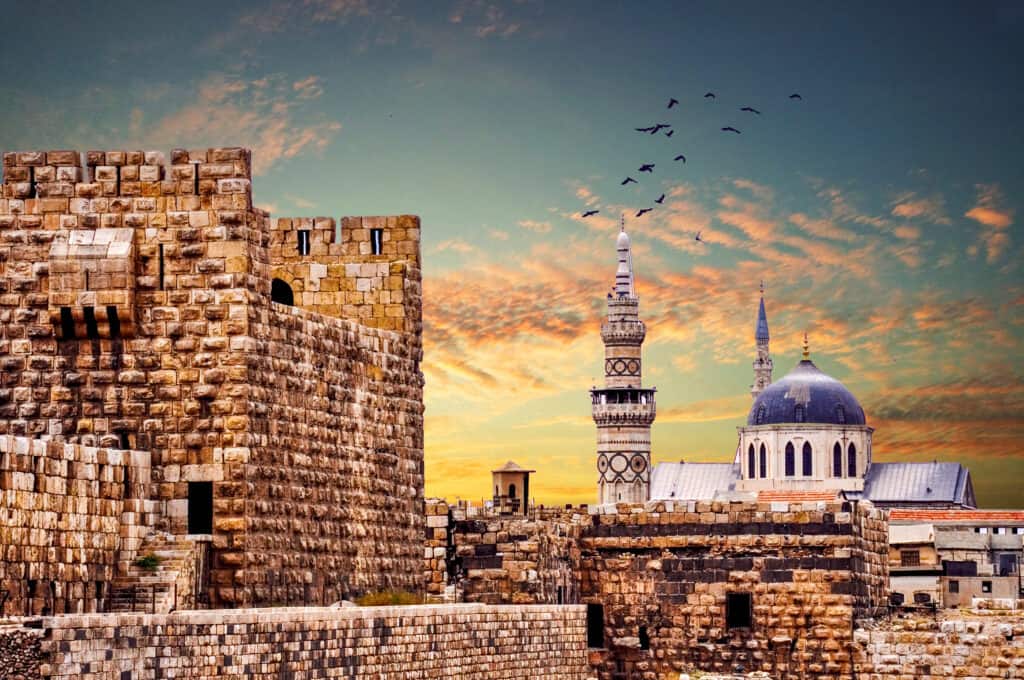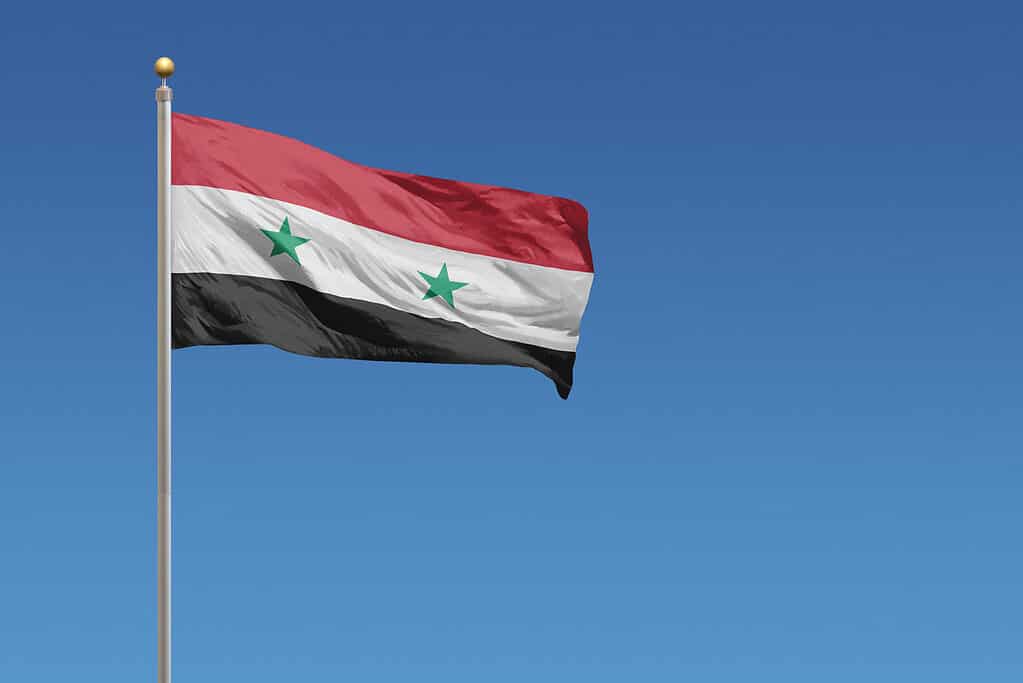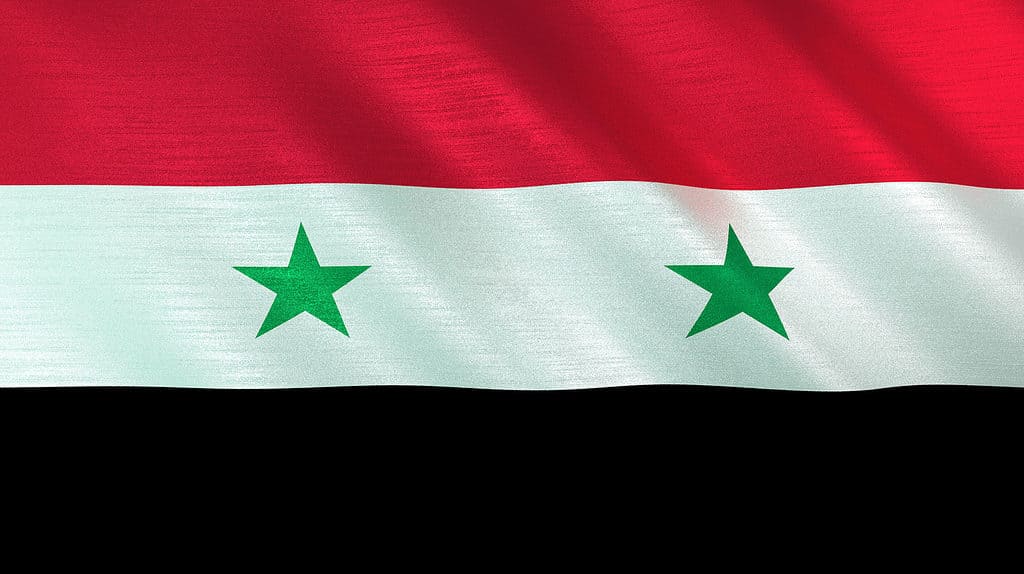Officially the Syrian Arab Republic, Syria is a country located in southwestern Asia on the east coast of the Mediterranean Sea. The state shares borders with other countries, like Turkey to the north, Israel and Lebanon to the southwest, Iraq to the east and southeast, and Cyprus west of the Mediterranean Sea, which lies west of the country itself. Syria is home to a diverse landscape and diverse people, with a unique flag representing the various ideologies that the country stands for. Discover the history, meaning, and symbolism of the Syrian flag in this post.
Syria: Geography and Climate
Syria consists of mountains, deserts, and fertile plains; it also splits into two major regions- the western and eastern regions. These two regions are divided by the Great Rift Valley (Jordan Rift Valley). The western region contains more mountain ranges, while the east is home to the Syrian desert, which covers over 200,000 square miles. The highest point in the country is Mount Hermon (Jabal Al-Shaykh), which reaches a height of 9,232 feet (2,814 meters). Other smaller mountains are also scattered around the country. Syria is also home to several notable rivers, particularly the Orontes River, which flows through the rift valley, and the Euphrates River, which starts in Turkey and flows through Syria before entering Iraq.
Generally, Syria experiences a Mediterranean climate characterized by very hot and dry summers that last longer than average. However, even during this period, some parts of the country experience light summer rain. Generally, only the parts that are above 5,000 feet get to experience a bit of a breeze during the summer in Syria.
Syria: Culture and Cuisine

Damascus, Syria is one of the oldest cities in the world.
©Mahmod5cy/Shutterstock.com
The country is home to over 16 million people spread across a total area of 185,180 square kilometers (71,498 square miles). The country is the 25th largest in Asia by land area and is in the top 100 most populated countries in the world. Despite not having too many inhabitants, the country is still one with many diverse cultures. The people of Syria cannot be traced to an exact location and are believed to have evolved from different origins over an extended period of time. Despite this variation, Syrians are all thought to be Levantine people, hailing from a historically sizable region in Western Asia’s Eastern Mediterranean region.
Like its people, the cuisine of Syria is also diverse; developing over the years by adding different styles of cooking and ingredients from people who settled in the country and even neighboring regions throughout its history. Because of its diversity and how old some of its methods and ingredients are, Syrian cuisine is regarded as one of the most ancient in the Arab world. Despite having certain similar dishes, the different regions of the country each have unique dishes and cooking methods.
Syria: Language and Religion
The official language of Syria is Arabic. Despite having an official language, they all have distinct ways of speaking the language. In other words, different variations of Arabic are spoken in Syria, such as Levantine Arabic, also known as Shami, which is spoken in the west. There is also the Mesopotamian variation spoken in the northeastern part of the country. Before the advent of Arabic, the official language of the country was Aramaic. Other unofficial languages spoken in the country include Turkish, Greek, Armenian, and Kurdish.
Most of the inhabitants of Syria are Muslims, most particularly Sunni Muslims. Despite having more than half of its population practicing Islam, the country still permits the practice of other religions like Christianity and Judaism. Many of the Christians in the country practice Greek Orthodox Christianity, as well as Syriac Orthodox, Greek Catholic, Syriac Catholic, Armenian Orthodox, etc.
History of the Flag of Syria

Syria’s current flag was initially adopted in 1958.
©iStock.com/Derek Brumby
The current flag was initially adopted in 1958 and was used from then until 1961 to represent Syria as a member of the United Arab Republic before it was readopted in 1980. Syria adopted the flag of the United Arab Republic to demonstrate its support for Arab unity even though it is not a member of any Arab state union.
The first flag of Syria was adopted in 1918, and this represented the Kingdom of Syria until 1920. This flag had a black, green, and white triband with a red triangle and a white star in the center on the hoist side. When the French took over the region, a new flag was hoisted and flown between 1920 and 1932. This flag had a horizontal green and white triband with the French tricolor in the center. With the country’s independence came a new flag, which was later designated as the Freedom Flag and flown from 1932 to 1958, then once more from 1961 to 1963.
Flag of Syria: Meaning and Symbolism

The red color on the Syrian flag represents the blood shed by the forefathers of Syria during their fight for independence.
©iStock.com/Maksym Kapliuk
The Syrian flag is made up of four colors; red, white, black, and green. The red, black, and white colors are incorporated into the flag in form of horizontal bands- the upper one is red, the middle is white, and the bottom one is black, while the green takes the form of two five-pointed stars in the middle of the white band at the center of the flag. Like the flags of many other countries, the colors on the flag of Syria have different meanings. The red on the flag signifies the blood shed by the forefathers of Syria during their fight for independence, and it also signifies the Hashemite dynasty. The white is used to represent the Umayyad dynasty, as well as a bright and peaceful future. The black represents the Abbasid dynasty and the strength of the Syrian government, while the green represents the Fatimid dynasty or the Rashidun caliphs. The stars, on the other hand, represent Egypt and Syria.
Up Next:
26 Countries With Tricolor (Triband) Flags
Red Flag with Yellow Star: Vietnam Flag History, Meaning, and Symbolism
The 10 Countries With Stars On Their Flags, and Their Meaning
The photo featured at the top of this post is © iStock.com/bodrumsurf
Thank you for reading! Have some feedback for us? Contact the AZ Animals editorial team.






